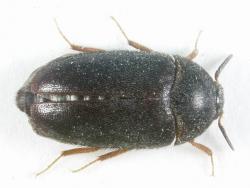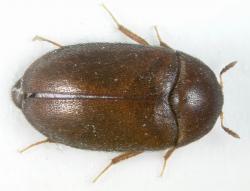Adult
Size
2.8 to 5 mm long.
Aspect
Egg-like, elongate shape, round at the ends. Look like coffee beans when seen from a distance. A homogenous and inconspicuous dark pubescence covers the body and legs. Golden bristles scattered on the ventral face.
Rather small head, clearly protruding from the prothorax, eyes wide apart, short 11-articled antennae.
Transverse pronotum, twice as wide as long, and wider and wider toward the rear part. In males, the last antennal article is 2.8 to 3.4 times as long as the previous two put together.
It is about the same length as the length of those two articles put together in females.
Colour
Reddish brown to black, the pronotum is usually slightly darker than the elytra. The males’ antennal club and the females’ last antennal article are darker than the rest of their antennae. Legs are red to reddish.


 Attagène des tapis
Attagène des tapis  Black carpet beetle
Black carpet beetle  Escarabajo negro de las alfombras
Escarabajo negro de las alfombras  Dunkler Pelzkäfer
Dunkler Pelzkäfer 


